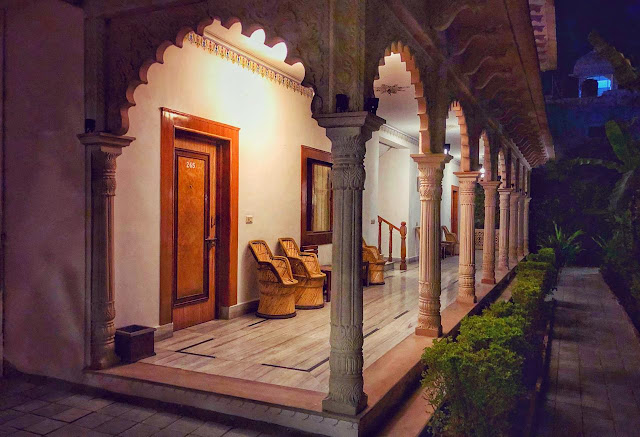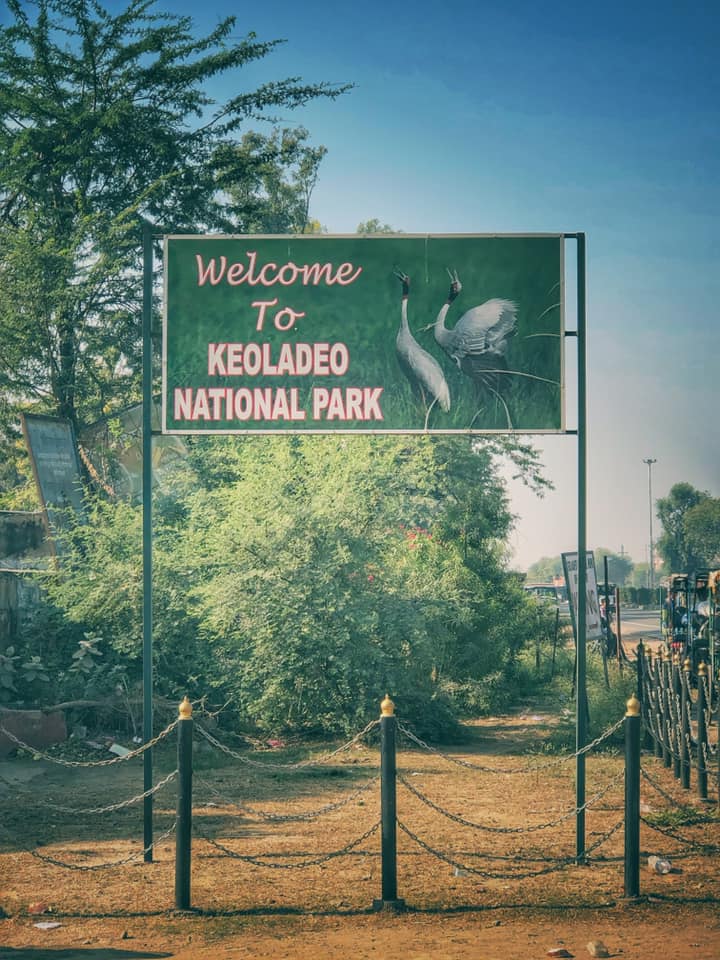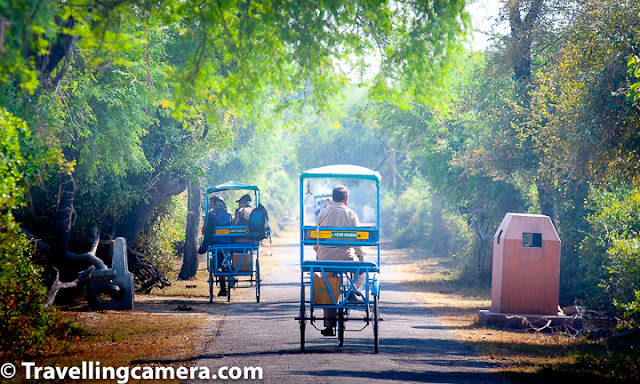We had always planned of visiting Keoladeo National Park at Bharatpur, Rajasthan, but it never materialized. Until November 2018. Nights were getting colder and the afternoon Sun had started losing its edge. News of migratory birds arriving in India had started floating. The plan to visit the Bird Sanctuary was on spur of the moment, as most good plans are. Once we had decided, we had two days to prepare for our trip, which included booking the hotel, researching, planning the itinerary etc.
The first thing we did was book a hotel at walking distance from the gate of the National Park. We found The Sunbird quite interesting. It was about 500 metres from the National Park and was also recommended by other bloggers. Then we packed the essentials, which included the following:
1) Comfortable Summer Clothes - long-sleeved, cotton, comfortable
2) Comfortable walking shoes
3) Sunglasses
4) Sunscreen
5) Binoculars
6) Camera and lenses
7) The last thing we put in the bag was our copy of A Pictorial Field Guide to the Birds of India, and I will tell you why we needed more time to pack the book in a while.
The next thing we did was make sure our car was equipped for the longish drive (~180km) across the state border. We checked that the insurance was valid and the pollution check was up to date. We also made sure that that the petrol was topped up and the tires were fine. Ours is an old car (>10 years) but has never given us trouble. We have clocked more than 1.3 lakhs kilometers on it and have also taken it on long drives. But we aren't seasoned highway drivers so extra precautions are needed.
The last thing we did before heading out was that we went through the website Avibase, and marked out all the birds we may come across at the national park. At that time, we did this more out of excitement, but later found out that this was a really helpful activity. When we saw new birds at the sanctuary, we found it easier to identify them immediately. Almost all the time we were aware of what we were seeing, and what we should look forward to. Once we had marked the birds, we put the book back into our sack.
We started the trip before dawn at around 5am. We took the expressway and then took the exit to the Hathras-Mathura Road. Then we took the Bharatpur-Mathura Road to reach the Keoladeo National Park in about 3 hours 30 minutes. Following is the route we followed.
We reached Bharatpur at about 9 am. The hotel wasn't ready for us by then so we decided to have breakfast and head to the park. We only had one light backpack so luggage wasn't a problem. We discovered that breakfast at Hotel Sunbird was very expensive, so we headed to the nearby Hotel Om Sai and had some really nice parathas with Dahi there and then a cup of tea each. The food here was tasty, but the service was slow, so be prepared for that if you choose this option.
From Hotel Om Sai, the entrance to the park was only about 300 metres. We reached there at about 10:30am and bought our tickets and then started our walk immediately.
Most of our itinerary till now was not really final. For example, till the last moment, we were not sure whether we would be covering Fatehpur Sikri during this trip. We decided that we will go with the flow. And this was the best decision we made.The only thing we knew for sure was that we both had had a stressful time at work and wanted to walk it off. We knew that we would not be taking any ride to go into the park and would walk all the way - to and fro. While it worked for us, we should share that it is 5km one way to the Shiv Temple and it can get really tiring especially if the sun is out. So carry lots of water and energy bars to keep yourself well-nourished.
If you do not wish to walk the entire way, you can hire a rickshaw. The rickshaw costs about 100 rs per hour + 100 hours for the binoculars. It you are not much of a walker, this is a good option. The Rickshaw pullers are very knowledgeable about the birds too. And almost always give you the right details. We heard one rickshaw puller share minute details such as why the Ibis we were seeing wasn't a black Ibis, but instead a Glossy Ibis, and how the parrot we were seeing wasn't a parrot, but a parakeet. It was really impressive. So you can just hire a rickshaw and not go in for an additional guide.
The first few kilometres inside the park is normal jungle. You see some really pretty songbirds and impressive birds of prey on this stretch. There are some trails in this stretch that lead one off the beaten track. If you decide to take these, make sure you are wearing full length trousers because the bushes can be thorny and there's always a possibility of snakes etc. Also, don't head too deep into the forest, because it is easy to lose your way. We had a little adventure of our own, which I will share in a separate post.
At about half-way, you reach the canteen and the checkpost. After this, towards the right is the starting point for the boat ride. We could not experience this, but have heard good things about it. You can try it if you so wish. Also, after this, the wetlands start on both the sides of the track and you start seeing the waterbirds - both migratory and resident. Most of the birds we saw were resident, but if you head there in January or February, you will surely see many more migratory birds.
To know more about the birds and other fauna we saw here, please go through the following posts:
Birds we need help in identifying
We managed to cover the entire length of the walk and back before the closing time of the park (5pm). One mistake that we had made was that we didn't pack any lunch with us and as a result were dead tired and hungry by the time we got back. We went straight to the hotel, checked in, and then crashed. we slept for a couple of hours and then took a bath and headed out for dinner. Our tiredness was gone and with it our work stress too. For dinner we opted for Chacha Chicken Chacha Franky. The food was just okay and we wished we had gone over to Hotel Om Sai again.
It was only late in the night that we decided that we had had enough of the national park and the thought of going back again at sunrise did not seem as enticing anymore. So we decided to pack up and head to Fatehpur Sikri in the morning. That turned out to be a really "interesting" experience, and we will talk about it in another post.
The entire trip lasted about 36 hours, but it refreshed us and has motivated us to try more such adventures. We highly recommend a trip to the Keoladeo National Park, and not only for the vast variety of birds you will see here, but also for the experience. This is a well-managed national park and will help you reconnect with nature and rejuvenate. If you need any other information, you can write to us at VJ@travellingcamera.com or leave a comment on this post and we will be happy to answer.
We managed to cover the entire length of the walk and back before the closing time of the park (5pm). One mistake that we had made was that we didn't pack any lunch with us and as a result were dead tired and hungry by the time we got back. We went straight to the hotel, checked in, and then crashed. we slept for a couple of hours and then took a bath and headed out for dinner. Our tiredness was gone and with it our work stress too. For dinner we opted for Chacha Chicken Chacha Franky. The food was just okay and we wished we had gone over to Hotel Om Sai again.
It was only late in the night that we decided that we had had enough of the national park and the thought of going back again at sunrise did not seem as enticing anymore. So we decided to pack up and head to Fatehpur Sikri in the morning. That turned out to be a really "interesting" experience, and we will talk about it in another post.
The entire trip lasted about 36 hours, but it refreshed us and has motivated us to try more such adventures. We highly recommend a trip to the Keoladeo National Park, and not only for the vast variety of birds you will see here, but also for the experience. This is a well-managed national park and will help you reconnect with nature and rejuvenate. If you need any other information, you can write to us at VJ@travellingcamera.com or leave a comment on this post and we will be happy to answer.
















.jpg)
Comments